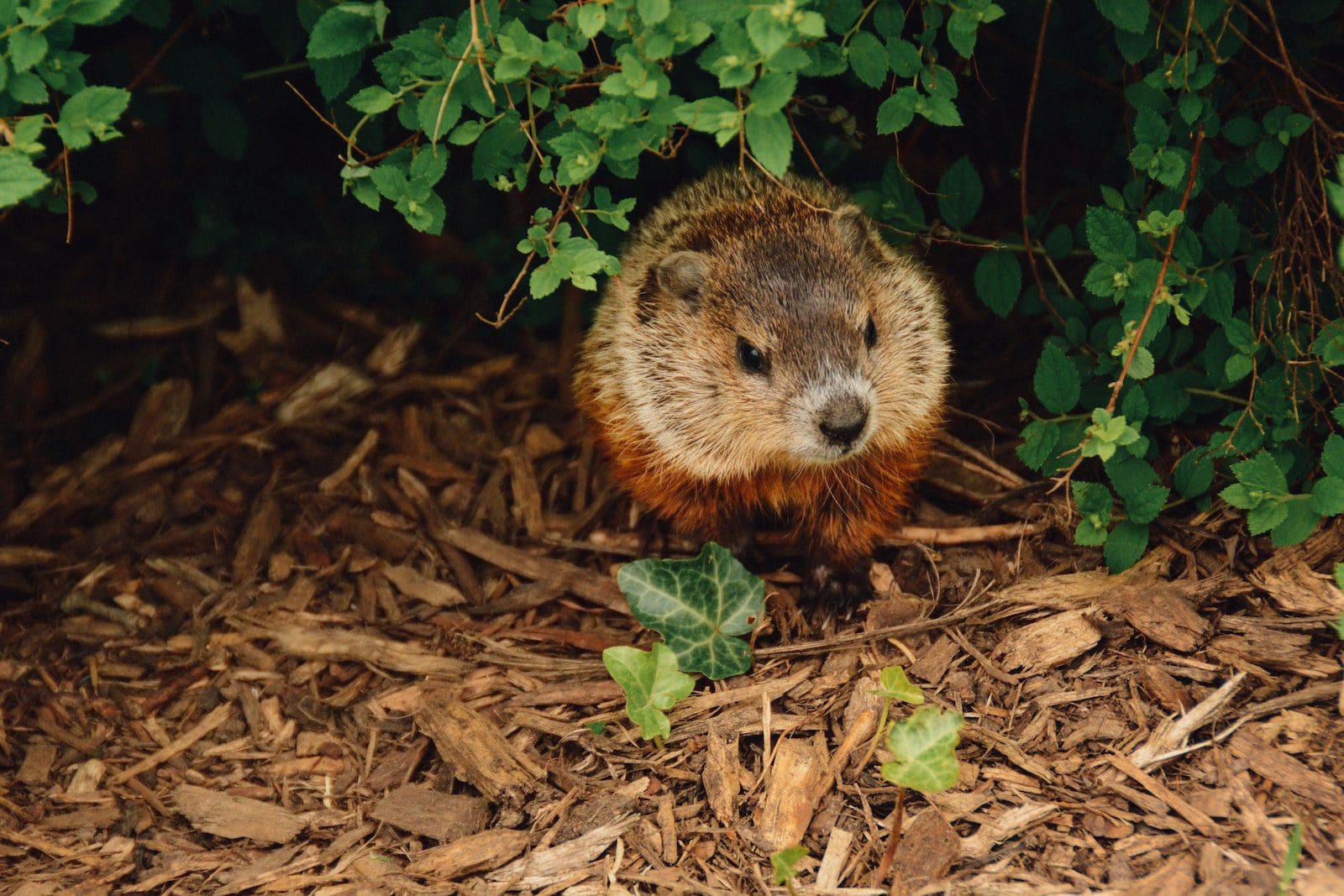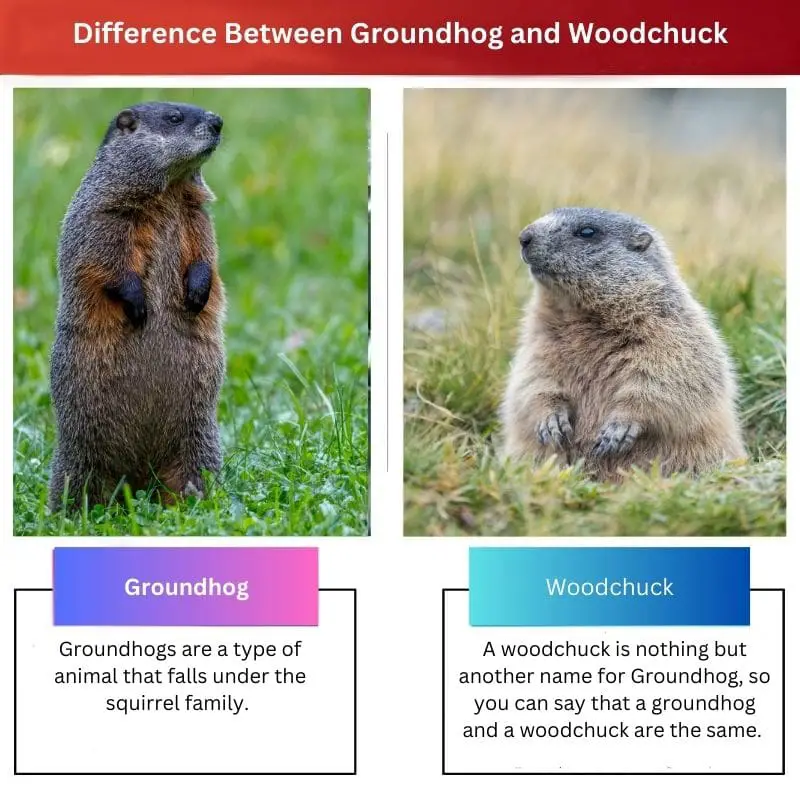A groundhog and a woodchuck are actually the same animal, known scientifically as Marmota monax. They are stout-bodied, burrowing rodents belonging to the squirrel family. Renowned for their digging abilities, these creatures play a vital role in their ecosystem by aerating soil and controlling vegetation growth.
Key Takeaways
- Groundhog and woodchuck are two names for the same animal, Marmota monax.
- Groundhog is more commonly used in the eastern United States, while woodchuck is more commonly used in the Midwest and Canada.
- Despite their name, groundhogs/woodchucks are a type of ground squirrel known for their burrowing behavior.
Groundhog vs. Woodchuck
The groundhog, the woodchuck, or the whistle pig, is a burrowing mammal in North America. They are known for their ability to predict the end of winter by emerging from hibernation in early February. The woodchuck is a common name for the groundhog in some regions.

Comparison Table
| Feature | Groundhog | Woodchuck |
|---|---|---|
| Scientific Name | Marmota monax | Marmota monax |
| Other Names | Whistle pig, land beaver, chuck | Whistle pig, land beaver, chuck |
| Habitat | Throughout North America | Throughout North America |
| Description | Brownish-gray, stocky body, short tail | Brownish-gray, stocky body, short tail |
| Behavior | Hibernates in winter, solitary | Hibernates in winter, solitary |
| Diet | Plants, fruits, vegetables | Plants, fruits, vegetables |
What is Groundhog?
The groundhog, scientifically known as Marmota monax, is a rodent native to North America. It is also commonly referred to as a woodchuck or a whistlepig. Groundhogs are celebrated for their purported ability to predict the arrival of spring, famously observed on February 2nd, a tradition known as Groundhog Day.
Physical Characteristics
Groundhogs measure about 16 to 26 inches in length, including their short, bushy tails. They have robust bodies, covered in coarse fur that ranges in color from brown to reddish-brown, with lighter underparts. Their large incisors are ideal for gnawing through vegetation and digging burrows. Groundhogs also possess keen senses, including sharp eyesight and acute hearing.
Habitat and Behavior
Groundhogs are primarily found in grasslands, meadows, and open woodlands across North America. They are proficient diggers, creating elaborate burrow systems that can extend up to six feet underground. These burrows serve as shelters and provide protection from predators. Groundhogs are diurnal creatures, meaning they are active during the day, feeding primarily on vegetation such as grasses, clover, and agricultural crops. During the winter months, they enter a state of torpor, reducing their metabolic rate to conserve energy.
Cultural Significance
The groundhog holds cultural significance, particularly in North America, where it has become a symbol of spring’s arrival. Groundhog Day, observed on February 2nd, involves the tradition of watching whether a groundhog emerges from its burrow. According to folklore, if the groundhog sees its shadow, it will retreat back into its burrow, indicating six more weeks of winter. If it doesn’t see its shadow, it suggests an early arrival of spring. This tradition has been popularized by events such as the annual Groundhog Day celebration in Punxsutawney, Pennsylvania.
Conservation Status
Groundhogs are not considered threatened or endangered and are classified as a species of least concern by the International Union for Conservation of Nature (IUCN). However, they may face habitat loss due to urbanization and agricultural development. Additionally, groundhogs can be considered pests in some areas, as they may damage crops and garden plants.

What is Woodchuck?
The woodchuck, scientifically known as Marmota monax, is a species of rodent native to North America. It is also commonly referred to as a groundhog or whistlepig. Woodchucks are known for their stout build and their remarkable digging abilities, which enable them to create extensive burrow systems in various habitats across their range.
Physical Characteristics
Woodchucks measure between 16 to 26 inches in length, including their short, bushy tails. They have stocky bodies covered in coarse fur that varies in color from brown to reddish-brown, with lighter underparts. Their large incisors are well-suited for gnawing through vegetation and digging burrows. Woodchucks also possess keen senses, including sharp eyesight and acute hearing.
Habitat and Behavior
Woodchucks inhabit a wide range of habitats, including grasslands, meadows, open woodlands, and even suburban areas. They are proficient diggers and create complex burrow systems that can extend several feet underground. These burrows serve as shelters for resting, hibernating during the winter months, and rearing young. Woodchucks are primarily herbivorous, feeding on a variety of vegetation such as grasses, clover, berries, and agricultural crops.
Reproduction and Lifecycle
Woodchucks breed in early spring, with mating occurring shortly after emerging from hibernation. After a gestation period of about 31 to 32 days, females give birth to a litter of 2 to 6 young, known as kits. The kits are born blind, hairless, and entirely dependent on their mother for nourishment and protection. They gradually grow and develop over the spring and summer months, reaching sexual maturity at around one year of age.
Interaction with Humans
Woodchucks can sometimes be considered pests, particularly in agricultural areas, where they may damage crops and garden plants. However, they also play a crucial role in their ecosystems by aerating the soil and providing habitat for other species. In some regions, woodchucks are hunted for their fur, meat, or as a means of population control.
Conservation Status
Woodchucks are not considered threatened or endangered and are classified as a species of least concern by the International Union for Conservation of Nature (IUCN). However, like many wildlife species, they may face habitat loss and fragmentation due to human activities such as urbanization and agricultural development.

Main Difference Between Groundhog and Woodchuck
- Naming:
- Groundhog and woodchuck are two common names for the same species, Marmota monax.
- Habitat:
- Groundhogs/woodchucks inhabit a variety of habitats including grasslands, meadows, open woodlands, and suburban areas.
- Behavior:
- Groundhogs/woodchucks are proficient diggers, creating complex burrow systems for shelter, hibernation, and raising young.
- Cultural Significance:
- Groundhogs are particularly famous for their association with Groundhog Day, a tradition where the emergence of a groundhog from its burrow is believed to predict the arrival of spring.
- Physical Characteristics:
- Groundhogs/woodchucks have stocky bodies covered in coarse fur, varying in color from brown to reddish-brown, with lighter underparts. They possess keen senses including sharp eyesight and acute hearing.
- Reproduction:
- Groundhogs/woodchucks breed in early spring, giving birth to litters of 2 to 6 young, known as kits.
- Interactions with Humans:
- While sometimes considered pests for damaging crops and garden plants, groundhogs/woodchucks play a crucial role in their ecosystems by aerating soil and providing habitat for other species.




